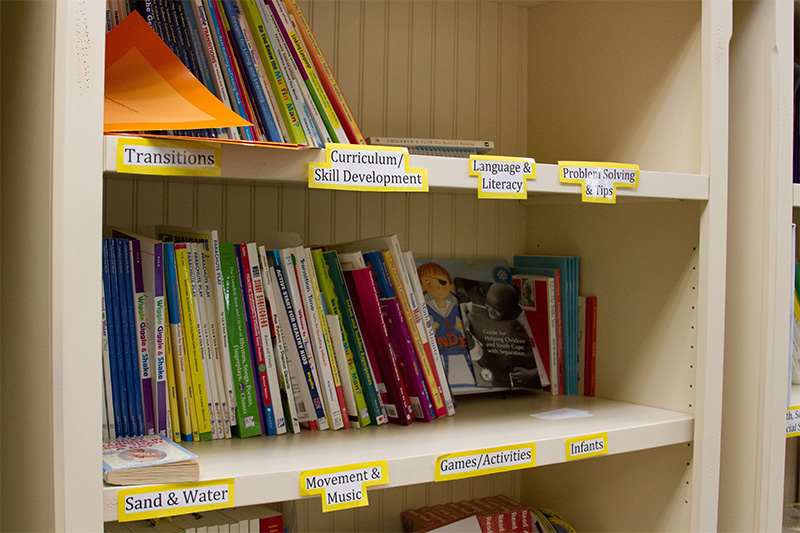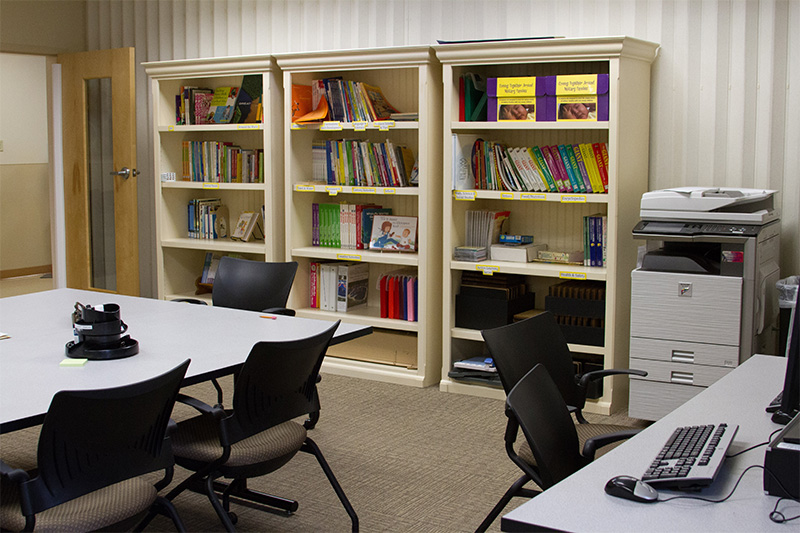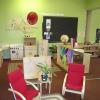- Provide and make available to staff a well-equipped professional resource library.
- Ensure that monthly training is completed, and work with child-development professionals to ensure that modules are completed.
- Model effective practices in designing a learning environment for children and adults.
Learn
Teach
Building a Professional Library
An important part of your role as a trainer or coach is ensuring that staff members have access to the resources they need to do their jobs well. Staff will often need professional development resources. These resources can take many forms: books, magazines, videos, curriculum tools, educational materials, website guides.
Here are some suggestions to help build a strong professional library:
- Request a subscription to the journals published by professional organizations.
- Look for useful books. Throughout the Virtual Lab School, you will find suggested readings. These books may be helpful additions to your resource library. You can also browse publishers’ tables at professional conferences for the latest titles.
- Help staff find appropriate websites and keep those bookmarked on devices in the professional library. Again, professional organizations are a good place to start. Many have links to important resources.
- It can be very helpful to construct a lending library of child and youth literature, toys, games, and other materials. These types of materials can help staff turn an idea into reality. Staff can find the resources they need right away. This also helps avoid duplication of resources across a program.
- Many curricula come with professional development resources. These may be videos, guides, or supplements. Keep any of these materials that staff are not using in a centralized location, so they can be found when needed.
- There are many ways to include cutting-edge video in your professional library. The Virtual Lab School is a free source of such video. See the Apply section for more ideas.
It can be helpful to see examples of programs’ professional resource libraries. Look at these photos of well-stocked professional libraries and quality work spaces for staff members. Are there ideas you can use in your own program?


Just as your facility requires restrooms for adults, so too your facility needs professional work space where staff can comfortably work on items for their classrooms. The availability of this area in your program can send a powerful message about how you value your teachers and caregivers as professionals. It may sometimes be difficult for staff members to work on children’s portfolios or assessments or the weekly curriculum if there is no desk or adult-sized chairs in their classrooms. If your space will permit, work with the program manager to offer some more adult-focused spaces with relevant resources, where staff can access not only the professional library items, but also computers, printers, copiers, and other relevant office supplies. This is a great way to support staff. If you have limited facility space in your program, consider making your break or training rooms multifunctional and allowing those to also be work-related spaces.
Building Learning Communities
As a trainer or coach in a center-based child and youth development program, one of your top priorities should be to build a community focused on learning for children and adults. One way you can do this is by building professional learning communities with staff. Professional learning communities are a form of ongoing professional development that emphasizes staff members’ own experiences and expertise. The graphic below helps you think about key features of professional learning communities:
| Professional |
|
| Learning |
|
| Community |
|
When these elements are in place, groups of child-development professionals can engage with one another to improve their professional practice. As a trainer or coach, you can facilitate this process and ensure that the structures are in place to continue its success.
Model
One of the most powerful strategies as a trainer or coach is modeling. As a trainer or coach, you ideally have a combination of expertise and experience in child development. You are a resource for the staff. As staff members are building new skills or trying new strategies, they may not feel comfortable using the skill right away. They may not completely understand what it looks or sounds like. They may need some guidance to feel comfortable trying out new skills. You can provide this guidance and provide a model for what the skill should look and sound like. Here are some guidelines for modeling with staff (Rush & Sheldon, 2013):
Also, remember that you, along with your program manager, can model the creation and maintenance of strong environments by incorporating some of the essential elements you want staff to enact in their classrooms into the other spaces staff use (e.g., your office, staff training rooms, staff break rooms, hallways). For example, consider:
- How staff can bring their full selves to staff spaces. Just as you want materials for children and youth to be authentic, meaningful, and reflective of their backgrounds and traditions, you should make sure that spaces for adults do the same. Do staff feel comfortable sharing their stories and personal lives? Do staff feel comfortable speaking in their preferred language(s) in staff spaces? Are materials available in multiple languages? Do materials represent staff members’ lived experiences?
- How materials for staff are organized. Are they arranged in such a way that you and the staff can easily access them? Are they arranged in such a way that they evoke learning? Perhaps in the staff break room you offer a small display of a new resource or a board sharing an interesting project recently completed by one of the classrooms. These small touches can evoke staff’s engagement.
- The aesthetics of the staff spaces. Are there home-like elements such as plants or soft furniture in your office or the break room? Are there ways you can incorporate nature, items of beauty, or the personality of your program into the other spaces staff use?
- The arrangement of your office or meeting space. If you have an office and it is the main space that you meet with staff, carefully consider how it is arranged. What messages does it send to staff about your role and theirs? For example, consider how different conversations feel around a table, on a couch, or across a desk. How is privacy protected for sensitive conversations and written documents or files like training plans? Are documents with names stored immediately, and are computers logged out?
Observe
Watch the following video to hear a Program Manager talk about how her team supports the creation and work of professional learning communities. Think about how you could work with managers to create environments like these for staff members.
Professional Development: Building Learning Communities
Monitoring Ongoing Professional Development
Before working with children, staff members should be oriented to the program’s philosophy, goals, expectations, procedures, curriculum, policies, and requirements. Then, staff should participate in an organized professional development program. The National Association for the Education of Young Children recommends staff members develop annual individualized professional development plans. Developing these plans will be covered in more detail in the Professionalism and Program Management courses. As a trainer or coach, you may be responsible for designing, delivering, and documenting a staff member’s progression through her or his individual professional development plan. It is important to be organized and proactive about this process. Here are strategies that can help:
- Create portfolios or binders for each staff member.
- Make checklists of completed training opportunities.
- Monitor progress through online training systems like the VLS or other professional development registries used by your program.
As you develop and update staff’s individual professional development plans, do not forget to include resources, training and documentation related to the preparation and maintenance of high-quality indoor and outdoor environments.
Explore
You are responsible for the professional development of a large number of staff members. This can be difficult to manage, and it requires complex organizational skills. Use the Supporting Adult Learners activity to reflect on your own practice. Think about how you can ensure all staff members engage in the professional development they need.
Apply
As a trainer or coach, you want to ensure that staff members have access to the resources they need. Review the different suggestions listed in the Tips for Building a Professional Resource Library handout for ideas that you could use to help encourage and support professional development.
Glossary
Demonstrate
Afterschool Alliance (2017). Resources to promote belonging and inclusion. https://afterschoolalliance.org/afterschoolsnack/Tools-to-Build-On-Resources-and-guides-for-parents-and_06-03-2020.cfm
Aguilar, E. (2020). Coaching for equity: Conversations that change practice. Jossey-Bass.
Barton, E. E., & Smith, B. J. (2015). The preschool inclusion toolbox: How to build and lead a high-quality program. Brookes Publishing.
Derman-Sparks, L., & Edwards, J.O. (2020). Anti-bias education for our children and ourselves (2nd ed.). National Association for the Education of Young Children.
DuFour, R., DuFour, R., Eaker, R., Many, T. W., Mattos, M. (2016). Learning by doing: A handbook for professional learning communities at work. Solution Tree Publishing.
Gerdes, J., & Jefferson, T. (2015). How a professional learning community changed a family childcare provider’s beliefs and practices. Young Children, 70(5), 8-13.
Rush, D., & Sheldon, M. (2013). The early childhood coaching handbook. Brookes Publishing.
Teaching Strategies (2021). Six positive messages for school and program leaders. https://teachingstrategies.com/blog/six-positive-messages-for-school-and-program-leaders/
Whitebook, M., & Bellm, D. (2013). Supporting teachers as learners: A guide for mentors and coaches in early care and education. Red Leaf Press.


